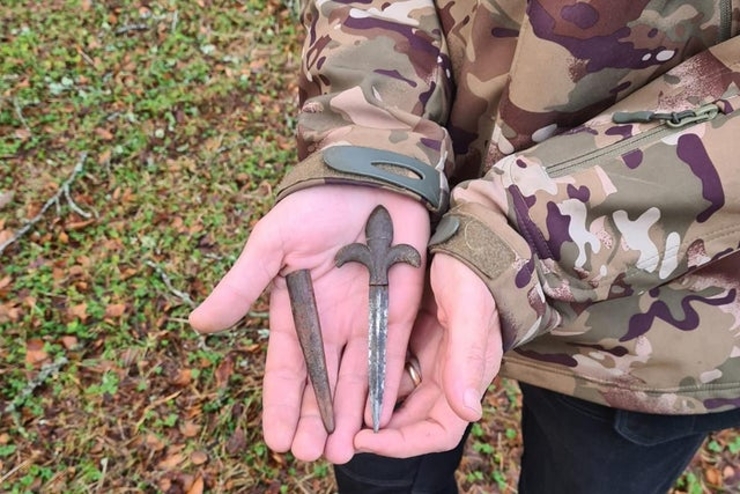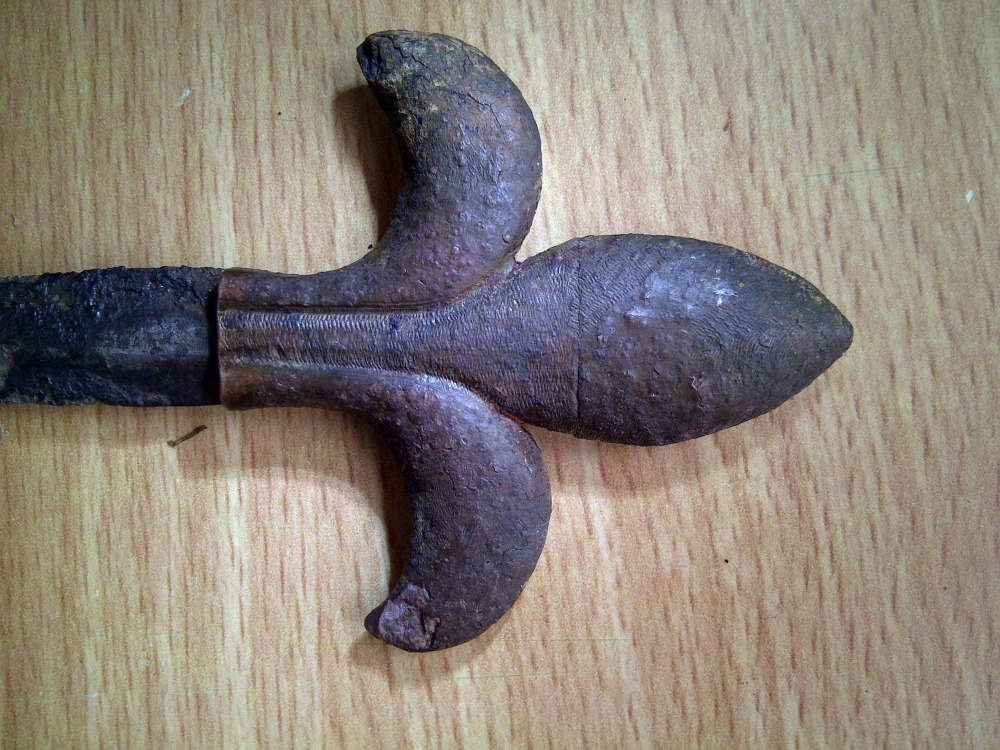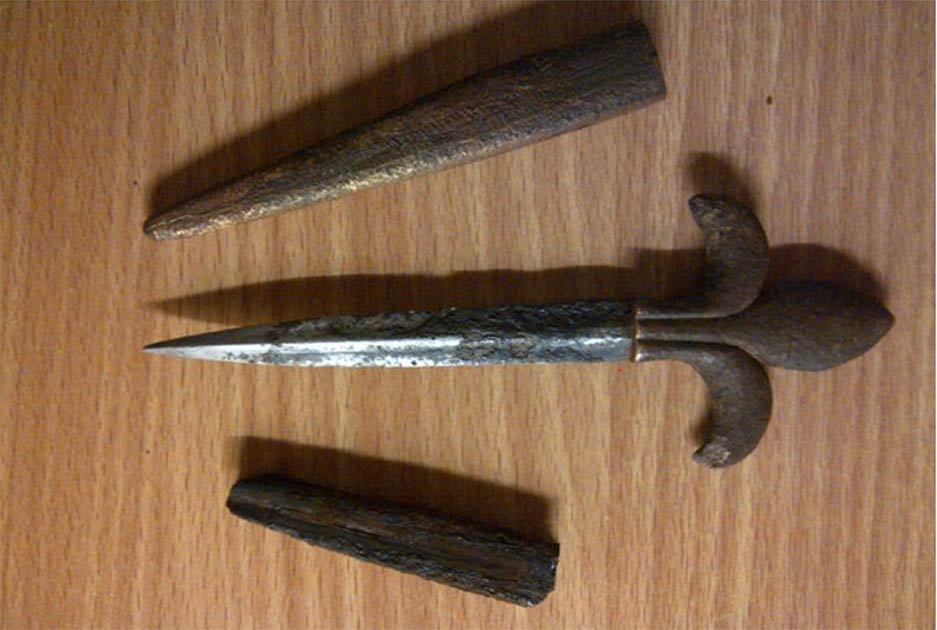Tohle je článek pro Hogo Fogo :)
Rare medieval knife rejected by archaeologists, detectorist paid for analysis and convinced them
Categories: Finds and rescue research abroad , Nálezy nejenom s detektorem ve Velké Británii a Irsku
Rare medieval knife rejected by archaeologists, detectorist paid for analysis and convinced them
Scottish lovinghistory buff and budding detectorist Craig Johnstone was searching the woods near Penicuik for traces of the 1666 battle. But on that day he made a find that at first not only he, but also the archaeologists he approached, thought was a modern affair and refused to accept. But they were wrong by several hundred years.
Craig first came across musket balls that confirmed his theory about the retreat of troops after the November 28, 1666, battle in the Pentland Hills. Later, however, he unearthed a small object that, more than anything else, resembled a piece of ornamental modern architecture: 'When I found the knife, it was covered in mud. It was hanging stuck inside its sheath and I thought it was just part of a railing that someone had cut off," Mr Johnstone explained. "I showed it to a couple of people; one of my friends worked for Midlothian Council so I took it to their archaeologist who immediately recognised it was a sheath knife. She advised us to heat it slowly, so we put it in the oven with the door open on a really low heat. When I pulled the handle out and there was a preserved blade, it was a moment for me comparable to the legend of Excalibur."
Mr Johnstone then showed his find to an independent expert in Edinburgh. "He recognised that the object was medieval but had no idea how old it was exactly - he guessed the knife was 16th century. "I subsequently realised I should have reported the find to Treasure Trove but they rejected it as a 'relatively modern item'. But Craig didn't think so, so he had an expert examination carried out at his own expense, using radiocarbon dating of the leather remains inside the scabbard, which established the exact age of the artefact as between 1191 and 1273!
The knife is of the Skean-Dhu type, which loosely translated from Gaelic means "hidden knife". These were refined weapons used mostly by nobles; they were so small that they could be easily concealed in sleeves or belts. It is a high quality blade with a hollow grind (a very sharp blade indeed - literally like a razor). The handle is bronze, but was originally gold plated. The once silver clad blade is about 7 cm long. There were also two pieces of leather inside the scabbard, which acted as a protective layer.
The shocking new information and details of the find were passed on to the Treasure Trove organisation. The knife would subsequently be assessed by the Scottish Archaeological Finds Assessment Panel. "It is a very ornate object for its time. It belonged to a nobleman or someone of high status, of special importance. It's an important find. There has never been one like it found before that was made so early," said a Treasure Trove spokeswoman. She added: "While the skin and blade date from the medieval period, the hilt and scabbard are unusual for this period. The find was due to be X-rayed, but due to limitations caused by Covid-19 this has not yet happened. Treasure Trove has not yet closed the case."
Although Mr Johnson has only been searching for six months, this is his second significant find in such a short time. He recently handed in a bronze spearhead, for which he received a reward of £200 (just under £6,000). But, as he says, it's not about the reward: 'None of this is about money or how much these things are worth. It's about Scottish history, and the knife has got just the recognition it deserves. "
Roman Nemec
Sources: ancient-origins.net, thehistoryblog.com, edinburghnews.scotsman.com


Detail of handle with decoration

The knife was still in excellent condition after hundreds of years.

The site of the 1666 battle
The article is included in categories:
- Archive of articles > Archaeology > Finds and rescue research abroad
- Archive of articles > Archaeology > Finds and rescue research abroad > Nálezy nejenom s detektorem ve Velké Británii a Irsku
Post
Tohle kdybych našel já tak se po**ru
Elmara : přesně :)
Úžasný nález, myslím že odedneška budu kopat i železné signály...:o)) co kdyby....
Ještě k tomu po půlroce hledání, to je dost velká motivace.
hezký nález
Krásný nález /super stav  Ani se nedivím že se odhadem o pár století sekli.Mysak-co třeba tlačná dýka to není zbraň?Navíc to bylo určené pro skryté nošení a boj/útok z blízka.To 30 cm čepel schováš špatně.(při správném použití ti stačí pár centimetrová čepel) Mám odevzdáno x artefaktů co se můžou pohybovat v rámci staletí nebo i tisíciletí ale přesně se to nedá(pokud není z hrobu/depotu)určit.Funkční věci se používaly/používají/kopírují dodnes.A nedivil bych se kdyby se toto objevilo za chvíli v nabídce nějakých nožů.A pokud je to jen nůž na dopisy tak i ten se dá použít líp než lžíce(záleží na situaci)
Ani se nedivím že se odhadem o pár století sekli.Mysak-co třeba tlačná dýka to není zbraň?Navíc to bylo určené pro skryté nošení a boj/útok z blízka.To 30 cm čepel schováš špatně.(při správném použití ti stačí pár centimetrová čepel) Mám odevzdáno x artefaktů co se můžou pohybovat v rámci staletí nebo i tisíciletí ale přesně se to nedá(pokud není z hrobu/depotu)určit.Funkční věci se používaly/používají/kopírují dodnes.A nedivil bych se kdyby se toto objevilo za chvíli v nabídce nějakých nožů.A pokud je to jen nůž na dopisy tak i ten se dá použít líp než lžíce(záleží na situaci) 
Elmara 
 koukám že totožné problémy mají odborníci napříč Evropou.
koukám že totožné problémy mají odborníci napříč Evropou.
Je to tak, je to tak, je to tak 

















